Table Of Content
Introduction
Blue Cat's Oscilloscope BeatM is a real time waveform analyzer exclusively available with Beat Magazine: it lets you visualize the content of an audio track and check its stereo phase on its XY view.
Blue Cat's Oscilloscope BeatM is a real time waveform analyzer exclusively available with Beat Magazine: it lets you visualize the content of an audio track and check its stereo phase on its XY view.
System Requirements
MacOS
- An Intel processor.
- Mac OS 10.5 or newer.
- Any VST / Audio Unit / RTAS compatible application (32/64-bit) .
Windows
- An SSE2-enabled processor (Pentium 4 or newer).
- Microsoft Windows Vista, Windows 7, 8, 10 or 11.
- Any DirectX / VST / RTAS compatible host software (32 or 64 bit).
For more information about supported platforms, see our Knowledge Base.
Installation
The plug-ins versions cannot be run standalone: they require a host application (see the System Requirements chapter for more information). Depending on which host application you use, you might need to install the plug-ins in different locations.
Before installing one of the plug-in versions, you should close all your host applications.
Windows
Install
All versions of the plug-in provide an installation program. Follow the steps of the wizard to install the software on your machine. During the installation you will be asked where you want the software to be installed. For the VST version, you should install the plug-in inside the VST plug-ins folder used by your host application(s). The default path set in the installer should work for most applications, but you should check your host software documentation to know where it looks for VST plug-ins. For other plug-in types, you should just use the standard path.
Some applications will not automatically rescan the new plug-ins, so you might have to force a refresh of the plug-ins list.
Upgrade
When a new version of the software is released, just launch the new installer: it will update the current installation.
Uninstall
To uninstall the software, simply launch the "Uninstall" program that is available in the start menu or in the configuration panel. It will take care of removing all files from your computer.
Mac
Install
On Mac the plug-ins are available as drive images. After download, double click on the file to open it. You can then drag and drop the file(s) to the shortcut that is provided within the image. It will install the software for all users on the machine.
In case you do not have admin rights on your Mac or if you want to install the software to another directory, just copy the files to the appropriate location. If required, more information is available in the README.txt file that is included in the package.
Upgrade
When a new version of the software is released, open the new image and copy the files over the previous ones. The new version will replace the older one.
Uninstall
To uninstall the software, simply remove the component(s) from the folder where you have copied them during install (move them to the trash).
First Launch
Blue Cat Audio plug-ins cannot be run standalone, they require a host application (see the System Requirements chapter for more information). Some host applications will require you to scan the plug-ins before they are available in the application.
If the plug-in is not available in the application, please check that it has been installed in the appropriate directory (with no host application running), and that the host application has scanned it.
Using Blue Cat's Oscilloscope BeatM
The User Interface
Note: The main toolbar, menus and basic features available with all our plug-ins are detailed in the Blue Cat Audio Plug-ins Basics section.
Blue Cat's Oscilloscope BeatM is bundled with a single skin. You may want to create your own or download new ones from www.bluecataudio.com. The included skin is composed of two panels:
- The time view, where you can actually see the audio waveform.
- The X-Y (or Lissajous) view, which displays an X-Y plots of the two waveforms (left/right or mid/side) to compare them and check their phase relationship.
Time View
When first opening the plugin, the Display pane is in 'Time' mode. In this mode the plugin displays waveforms (evolution of the audio signal over time).
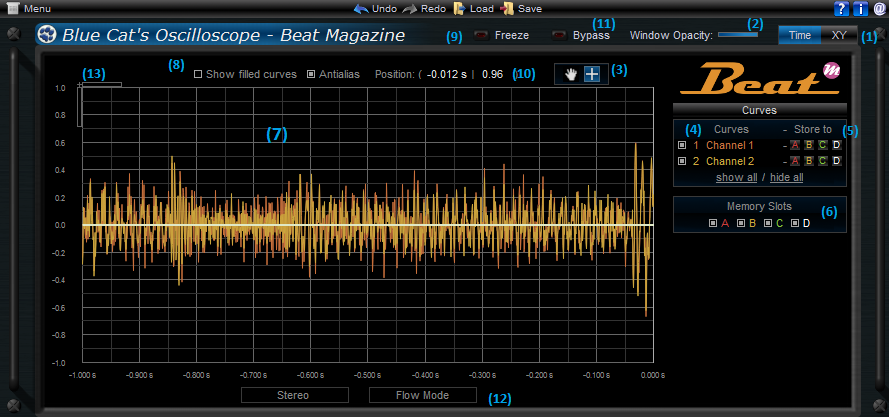
- Open the XY View.
- You can modify the opacity of the window that contains the plug-in user interface. Note that the result depends on the host application you are using.
- Two functions are available for the mouse on
the graph view: either drag the graph when zoomed or display the
coordinates of the graph below the mouse pointer and zoom by
selecting an area of the screen:
 At any time, right click on the graph to unzoom.
At any time, right click on the graph to unzoom. - Select the curves to display (Channel 1 or Channel 2, which corresponds to left-right or mid-side depending on selected mode).
- The four “A B C D” buttons let you store the curve to one of the proposed memory slots. The curves stored into these slots can be shown/hidden with the buttons available in (6). This is useful when you want to store and compare waveforms.
- Show/Hide curves stored in memory.
- The main waveform display. It shows the evolution of the signal over time.
- Display options:
- Show/hide filled curves: when on, the waveforms are filled with color. Uncheck this option for best performance in case your graphics card is slow.
- Anti-alias: when on, curves are displayed with a smoother shape. Uncheck this option for best performance in case your graphics card is slow.
- Freeze button: when clicked, the graph is frozen to let you analyze in details a snapshot of the waveform.
- Cursor position: displays the coordinates of the mouse cursor when over the waveform. This lets you precisely measure the current waveform characteristics.
- Bypass: bypasses the current plugin. The waveforms will not appear anymore.
- Controls:
- Stereo/Mid-Side: click here to change the stereo mode. By default ('stereo') channel 1 is left and channel 2 is right. In 'Mid-Side' mode channel one becomes the mono part of the signal (Mid) and the second channel is the stereo part of the signal (Side).
- Flow/Loop:Click here to change the display mode.
- These two sliders let you control the x and y zoom for the graph. When the zoom factor is greater than one, you can drag the graph with the mouse when the cursor is a small hand, or drag the rulers on the left and bottom of the graph anytime.
XY (Lissajous) View
In this mode, you can see an X-Y representation of a stereo signal, displaying the first channel (left or mid) on the Y axis and the second channel (right or sides) on the X axis. (you can read more about X-Y analysis in the usage section):

- Two functions are available for the mouse on the graph view: either drag the graph when zoomed or display the coordinates of the graph below the mouse pointer and zoom by selecting an area of the screen, just like in the time view.
- Connect Points: when this option is checked, points are connected by segments. Without this option, only dots are plotted on the graph.
- Time amount: this controls the portion of the waveform used for the XY display. With 100% the whole second you can see in the time view is displayed. Reducing the amount of time lets you see instant changes, whereas increasing it shows you a more averaged view of the waveforms over time.
- Density: the larger the value, the larger the number of points are sampled and plotted on the graph. It is sometimes necessary to adjust this value for a clearer display and better performance (the larger the value, the more CPU the rendering requires).
- Click here to change the display mode (flow or loop). Note that loop mode in this view results in slower updates, which is not suitable for real time monitoring but rather for average waveforms relationship analysis. It is recommended to setup the time amount to 100% for continuous display.
- Click here to change the stereo mode. By default ('stereo') channel 1 is left and channel 2 is right. In 'Mid-Side' mode channel one becomes the mono part of the signal (Mid) and the second channel is the stereo part of the signal (Side).
- Use these sliders for zooming the view. It is also possible to zoom directly by selecting a portion of the graph, just like in the Time view.
- The graph displays the relationship between the channel 1 and channel 2 waveforms
The various elements of the user interface (knobs, sliders, buttons...) are simple and intuitive to operate, but more information about how to interact with them is available in the "Plug-ins Basics" chapter of this manual.
Operation
X-Y View
The X-Y view is a very simple tool to compare several waveforms. A typical usage is to check the phase of a stereo recording using the left and right waveforms.
The principle is described hereafter:
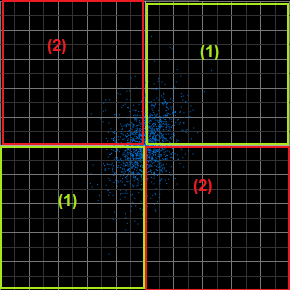
Each blue dot corresponds to a sample value. Its x coordinate corresponds to the value of the second channel (right or sides) for this sample, and the y coordinate corresponds to the value of the first channel (left or mid) for this sample. The display can be divided into two zones:
In phase values: the values plotted in this area are in phase.
Out of phase values: the values plotted in this area are out of phase.
It is thus very easy to determine whether the waveforms are in or out of phase (see the examples in the table below). The relative intensity of both waveforms is also easy to see on the graph: the closer to the X axis, the larger the relative value of the Y waveform compared to the X waveform.
Note: when used in mid/side mode, the displayed graph is just rotated by 45 degrees.
|
Waveforms correlation and XY graph shape |
|
 |
Uncorrelated waveforms Both waveforms have nothing in common. In this case the graph shows a cloud with no particular direction. In the case of a stereo signal (X=right, Y=left), it means that there will be no phase cancellation when mixing both channels into mono, and that the signal strongly sounds stereo. |
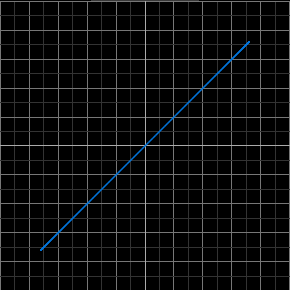 |
Strongly correlated waveforms On the graph shown here, both signals are identical. Signals that are strongly correlated will display a similar shape, close to the Y=X axis. In the case of a stereo signal (X=right, Y=left), it means that both channels are strongly correlated, close to a mono signal. |
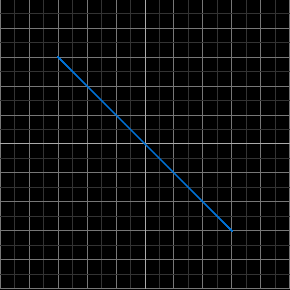 |
Anti phase waveforms The graph here shows two signals with opposite phase. Signals are strongly correlated but if they are summed together, it will produce silence. |
Blue Cat Audio Plug-Ins Basics
This chapter describes the basic features that are common to all our plug-ins. If you are already familiar with our products, you can skip this part.
User Interface Basics
About Skins
Like all Blue Cat Audio plug-ins, Blue Cat's Oscilloscope BeatM uses a skinnable user interface. It means that the appearance and behavior of the user interface can be entirely customized.
Especially with third party skins, the experience may be quite different from the one offered by the default skins that we provide. However, our plug-ins and our skinning engine have several standard features that will be available whatever your favorite skin. This is what is described in this chapter.
More information about custom skins can be found in the skins section.
Main Toolbar and Menu
Menu
If you right click on the background of the plug-in, the following pop-up menu appears:

The description of the commands associated to each menu item are available below.
Toolbar
In some skins, an optional toolbar gives you access to the some of the functionalities of the main menu.
| Icon | Name | Function |
|---|---|---|
|
|
Menu | Open the main menu |
|
|
Undo | Undo |
|
|
Redo | Redo |
|
|
Load | Load Preset |
|
|
Save | Save Preset |
|
|
Manual | User Manual |
|
|
About | About |
|
|
Website | Opens our website |
Commands
The Commands available from the main menu or the toolbar are:
- Set Preset Skin: change the skin for the current preset.
- Use Global Skin: use the skin defined in the global settings for the current preset. This item is enabled only if a skin has been defined for the current preset.
- Undo/Redo: undo or redo the latest modifications. This includes all changes made to the current preset settings.
- Load Preset: load preset from file.
- Save Preset: save current preset to file.
- Presets Settings: open the presets settings window. It enables you to change the skin and MIDI settings for the current preset.
- Global Settings: open the global settings window. It enables you to change the skin and MIDI settings that are used by default in all instances of the plug-in.
- User Manual: open this user manual.
- Check Updates: check the updates for this software on our website.
- Get More Skins: get more skins for this software.
- About: displays the “about” dialog box.
MIDI control
Blue Cat's Oscilloscope BeatM can also be remotely controlled via MIDI using MIDI CC ("Control Change") messages if your host application supports it. It is possible to customize the channel, control numbers and range used for each parameter in the MIDI settings panel available from the main menu (see the Plug-in Settings chapter for more details).
Controls
Examples
Here are a few examples of typical controls you will encounter in the user interface of our plug-ins:
| slider | slider | knob | button | Text control |
|
|
 |
 |
|
|
Interacting with Controls
You can interact with the controls of the plug-in interface either with the mouse or the keyboard.
Setting the keyboard focus on a control (so that it responds to key strokes) may be automatic (when you pass the mouse over it it gets focus) or manual (you have to click on the control to set the focus on it). Note that all host applications behave differently regarding keyboard handling. In some applications you may not be able to use all keys described later in this manual to interact with our plug-ins. It is usually made obvious to you to know the active surfaces of the skin (the places where you can click with the mouse): the mouse cursor usually changes when you can do something on a control. In the default skins delivered with the plug-in, the cursor changes to a small hand or an arrow to tell you when your mouse is over an active control.
Mouse
Various mouse movements will let you interact with the controls:
| Mouse Interaction | Action |
|---|---|
| Left Click | Acquire focus and start dragging or push (button) |
| Left Click + Alt Key | Set the value to default |
| Left Double Click |
Acquire focus and launch the “fine
tuning” edit box (except button):
 |
| Right Click | Set the value to default |
| Mouse Wheel | Increment or decrement the position (focus required) |
| Mouse Drag | Change the control position depending on mouse movement (except button) |
Keyboard
All control widgets support the following keys (note that some of them are caught by the host and thus never forwarded to the control. For example in Steinberg Cubase SX you cannot use the arrow keys to control the plug-in):
Keys Common to All Controls
| Key | Action |
|---|---|
| Up Arrow | Small increment of the position (up or right) |
| Down Arrow | Small increment of the position (down or left) |
| Left Arrow | Same as Down Arrow |
| Right Arrow | Same as Up Arrow |
| Page Up | Large increment of the position (up or right) |
| Page Down | Large decrement of the position (down or left) |
| + | Small increment of the value of the control |
| - | Small decrement of the value of the control |
| d | Set to default value (same as mouse right click) |
| e |
Opens the 'fine tuning' window to precisely
set the parameter:
 |
| SHIFT | When the key is down, the fine tuning mode is on, and you can modify the value with better precision when moving the mouse, the mouse wheel or using the keyboard. Just release the key to get back to the normal mode. |
Keys Specific to Buttons
| Key | Action |
|---|---|
| Enter | Pushes the button |
More
Check our online tutorial for more screenshots and more examples of our plug-ins user interfaces.
Blue Cat's Oscilloscope BeatM Parameters
All parameters described below can be automated and controlled via MIDI if your host application supports it. You can precisely define this behavior in the settings panels described later in this manual.
The input parameters of this plug-in are described below. They affect the audio analysis for the current instance of the plug-in.
|
Param id |
Name |
Unit |
Description |
|---|---|---|---|
|
dsp.input0 |
Bypass |
|
Bypass the plugin. |
|
dsp.input1 |
Stereo Mode |
|
This parameter controls the channels used for waveforms in the current plugin. 'Stereo' uses Left and Right channels and 'Mid-Side' adds an MS matrix to display Mid and Side channels waveforms. |
|
dsp.input2 |
View Mode |
|
Controls the way the data is fed into the output curves: in 'Flow' mode, the waveform flows in real time (each new sample pushes the older samples to the past), whereas in 'Loop' mode, the new samples loop back to the beginning of the wavefor when the one second buffer is filled. |
Blue Cat's Oscilloscope BeatM Curves
The Oscilloscope BeatM plug-in's main purpose is to provide visual feedback about the audio content of the audio signal. This is done thanks to several output curves. The plug-in has two channels. In stereo mode, channel 1 is left and channel 2 is right. In Mid / Side mode channel 1 represents the mid channel (mono part of the signal) and channel 2 the side channel (stereo part of the signal).
|
Curve id |
Name |
Description |
|---|---|---|
|
dsp.output_curve0 |
Instant Waveform (1) |
Instant audio content for channel 1. |
|
dsp.output_curve1 |
Instant Waveform (2) |
Instant audio content for channel 2. |
Plug-in Settings
In addition to the controls offered in the main user interface, Blue Cat's Oscilloscope BeatM has various settings that let you fine tune the behavior of the plug-in. You can choose to change these settings either for the current preset or globally for all instances of the plug-in.
The Global Settings Window
The settings available in this window apply to all instances of the plug-in, for all presets, if not overridden in the presets settings. Consider these settings as “default” settings.
Global Skin
You can change the default skin for all instances of the plug-in: write the skin file path in the text edit box or click on the button to open a file chooser dialog. If you have several instances of the plug-in opened in your session, you will have to re-open the user interfaces of these plug-ins to see the skin change.
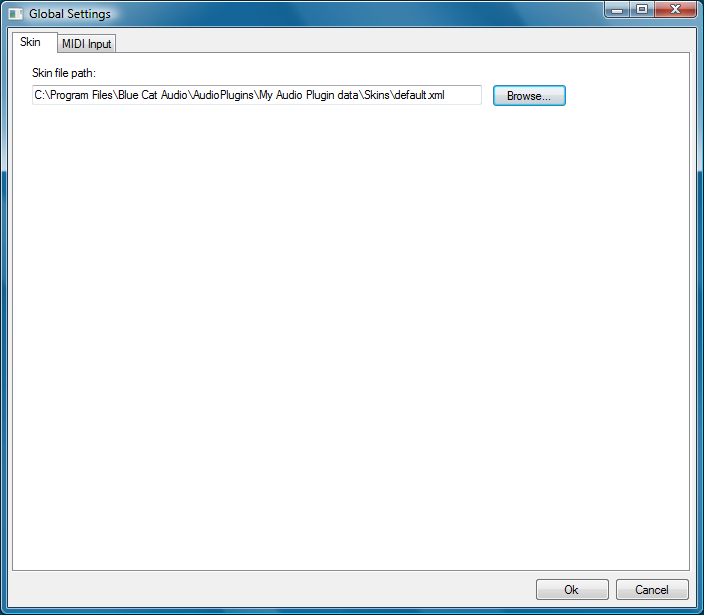
Global MIDI Input Settings
For each parameter you can define a default MIDI channel and CC number. You can then control the plug-in with an external MIDI controller or one of our plug-ins that generate MIDI messages.
The following settings are available for each plug-in parameter:
- Channel: MIDI Channel for the parameter control. If set to 0, the plug-ins will accept Control Change Messages from all MIDI Channels (MIDI Omni mode).
- CC: Control Change Number.
- Learn: click on this button to activate the MIDI learn functionality. When it is activated, you can move your MIDI controller, and the plug-in will automatically set the MIDI Channel and CC Number.
- Enable MIDI: enable/disable the MIDI control of the parameter.
- Response: response curve of the MIDI control: from very fast to slow control.
- Min: minimal value of the parameter when MIDI controlled.
- Max: Maximum value of the parameter when MIDI controlled.

Note: if the Min value is higher than the Max value, the response curve will be reversed: increasing the control value will decrease the parameter value.
Note: if you double click on the parameter text control boxes for the max and min values, a “fine tuning” edit box will appear and let you change the min and max values with more precision:

The Current Preset Settings Window
In this window you can change the settings for the current preset of the current instance of the plug-in only.
Preset Skin
You can choose to use the global skin setting or to change the skin for the current preset. This way you can have different skins for different instances of the plug-in in the same session in order to differentiate them.
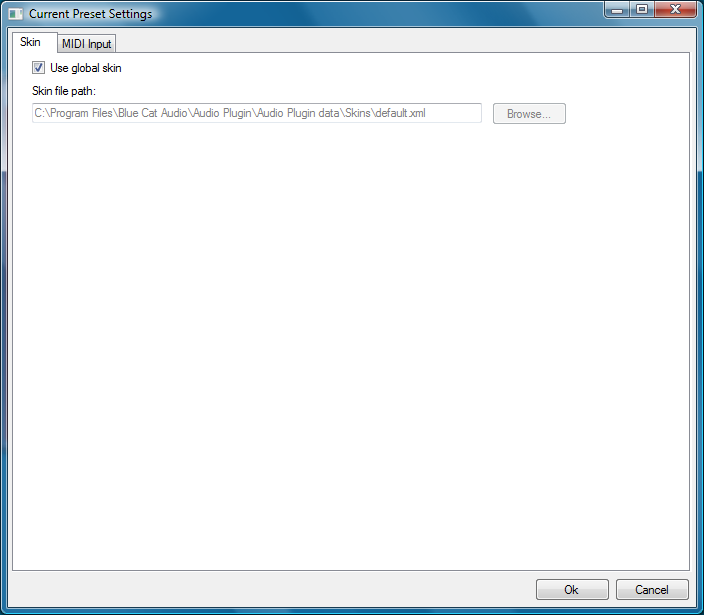
Preset MIDI Input Settings
Use the global settings or override them for the current preset. The parameters are the same as for the global input settings.
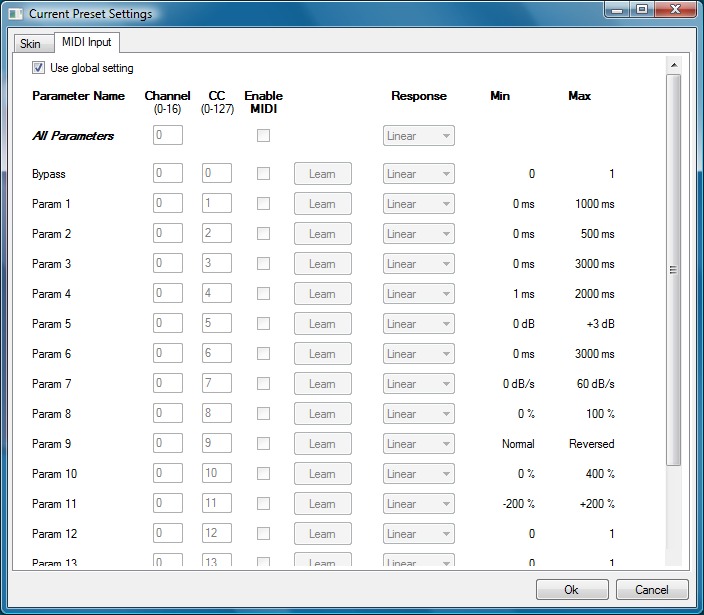
About Skins
Blue Cat's Oscilloscope BeatM integrates Blue Cat's skinning engine that allows you to customize the user interface. You can download alternate skins for your plug-in at the following address:
If you don't find a skin that fits your need or if you want a custom one, you can choose to create your own skin.
Choosing the Skin
There are two ways to select the skin of your plug-in: you can change the default (or 'global') skin, or change the skin for the current preset only (either in the preset settings page or from the main menu). The global skin applies to all plug-in instances (choose this one if you want to use the skin used by default, regardless of the session or preset), whereas the current preset skin only applies to the current preset of the current plug-in instance (use this one if you want to change only the skin for the current session/preset).
Note: in some host applications, the plug-in window won't resize automatically when you choose a skin with a different size. In this case, just close the window and re-open it: it will be displayed with the right size.
Selecting Skins
The global skin (used by default if no preset skin has been selected) can be changed in the global settings pane. The current preset skin can be changed in the preset settings page , or from the main menu, using the "Set Preset Skin..." command.
Create a Custom Skin
You can create custom skins for your plug-in in order to adapt it to your exact needs. You can change its look and feel and make it completely integrated in your virtual studio!
Just read the Blue Cat's Skinning Language manual and download the samples for the tutorial on http://www.bluecataudio.com/Skins. You can get ready to create your own skins in a few minutes. You can then share your skins on our website.
More...
This manual only covers the main aspects of Blue Cat's Oscilloscope BeatM. Our website offers many additional resources for your Blue Cat's Oscilloscope BeatM plug-in. It is constantly updated, so keep an eye on it!
Updates
We care about constantly updating our products in order to give you the latest technology available. Please visit our website often to check if Blue Cat's Oscilloscope BeatM has been updated, or subscribe to our Newsletter to be informed of the latest news about our products.
You can also follow us on twitter, facebook and instagram for almost real time updates notification, and subscribe to our YouTube channel to watch the latest videos about our software.
Versions History
Thanks again for choosing our software!

See you soon on www.bluecataudio.com!











